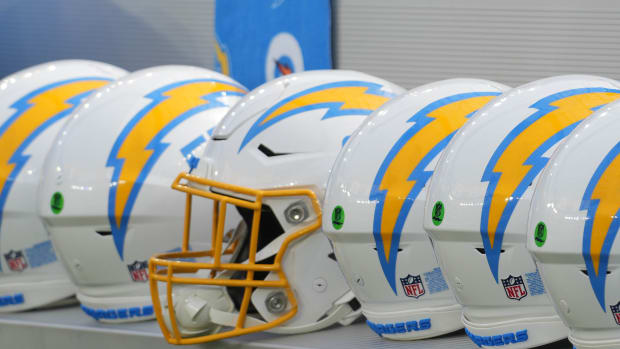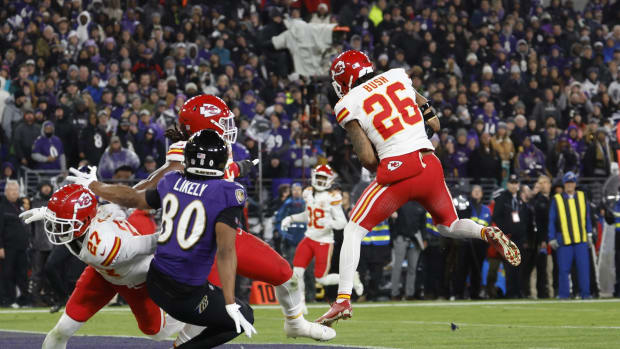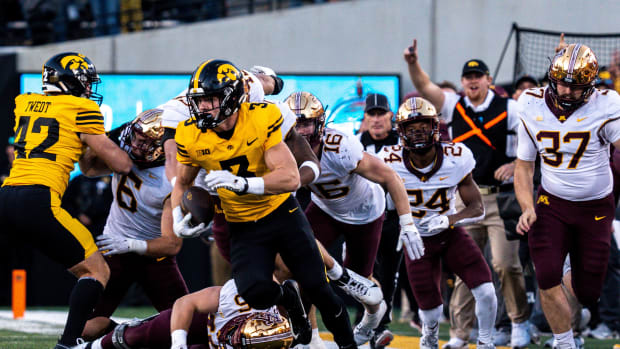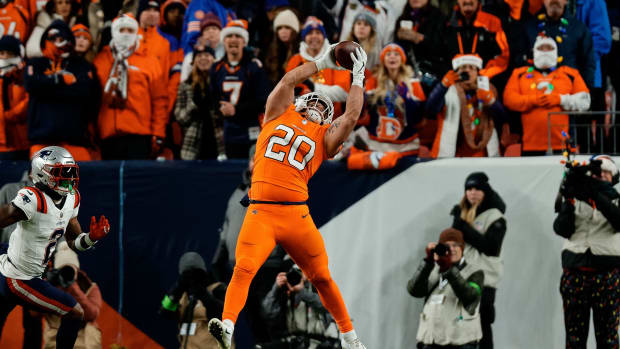Bengals follow front seven brotherhood's lead toward playoffs
There was something wrong with each and every one of them. Mike Zimmer, in his fifth season as the defensive coordinator for the playoff-bound Bengals, can quickly list the flaws that the NFL's hive mind perceived in the players who now form the heart of his 4-3 scheme. These players, in many cases, had exceedingly productive, even award-winning, careers for big-time college programs, but dropped through the draft, sometimes out of it entirely, to Cincinnati. Middle linebacker Rey Maualuga? "He had a reputation of overrunning things," says Zimmer. Weakside linebacker Vontaze Burfict? "He had a bad combine, and a bad senior year." Left defensive end Carlos Dunlap? "Had a reputation of being lazy." Right defensive end Michael Johnson? "Had a reputation of not finishing plays." Defensive tackle Geno Atkins? "His size [6-foot-1, 286 pounds] hurt him. People were looking for taller guys."
Of the 15 men whose names currently appear on the defensive line or at linebacker on the Bengals' depth chart, just one, strongside linebacker Manny Lawson, was a first-round pick, and Lawson wasn't particularly sought after upon reaching free agency in 2011 after six years in San Francisco, signing consecutive and relatively cheap one-year deals with Cincinnati. Four of them weren't drafted at all, including Burfict, the one-time All-American at Arizona State who started 14 games as a rookie this season.
Zimmer's front seven, in other words, does not appear to possess the pedigree of one that could make any claim to being the NFL's best. And yet, as they prepare for Saturday afternoon's playoffs-opening game in Houston against the more vaunted Texans, that is by many measures precisely what they are. After an uneven first eight games in which the Bengals went 3-5 ("Honestly, we started out bad," says Zimmer), Cincinnati's defense quietly coalesced into the league's stingiest unit. Over the regular season's final eight weeks, the Bengals ranked first in average points against (12.8 per game), second in sacks (31), second in turnovers (19) and third in average yards allowed (307.4). The team's only loss during that stretch came by one point, on a last second field goal by the Cowboys.
SI.COM'S 2012 PLAYOFF PREDICTIONS
While the Bengals secondary (all four starting members of which were first-round picks, though only cornerback Leon Hall was drafted by Cincinnati) played well -- it ranked seventh overall in pass defense (213 yards per game) and 16th in interceptions (14) -- the key to the team's surge to its second consecutive postseason berth was its front seven, soldered together with players who were not long ago widely viewed as misfits and spare parts. While the term "Moneyball" has these days become overused and often misapplied in sports and in the world at large, it is that philosophy's central tenant -- the identification and acquisition of undervalued assets -- that the Bengals have, to great success, exploited.
In the Bengals' case, the central type of undervalued assets they targeted were talented players who they were sure were drafted too low, due to a flaw or two, often behavioral, that they felt could be overcome. While other teams allowed them to fall to the next guy, in favor of safer if lower-upside alternatives, the Bengals again and again were happy to be the next guy. "A lot of these guys had first-round ability, and their stock dropped because of their reputations," says Zimmer. "The question about all of them was, 'Could they perform up to their level of ability?' That was the knock on 'em. I'm not saying we did it -- but they decided to perform, a lot."
This season, Burfict ranked 15th in the league in tackles, with 127, and Maualuga -- a second-round pick out of USC in 2009, despite being the Butkus Award winner and a unanimous All-American as a senior -- ranked 20th, with 122. Dunlap and Johnson, respectively second- and third-rounders despite decorated careers at Florida and Georgia Tech, combined for 17.5 sacks. But the best of them all is Atkins, the defensive tackle out of Georgia who lasted until the fourth round in 2010, and watched 119 players be selected ahead of him, because he was thought to be too small.
Atkins, who is 24, insists that he is merely a cog in the Bengals' front seven, a group that has nicknamed itself "the Brotherhood" not only because they are friends, and not only because they work with a fraternal symbiosis, but because they all know what it is like to have been underappreciated. "I think each of us has a chip on his shoulder, and we all have some baggage," he says. In most other years -- years that did not include the ball-swatting, quarterback-sacking force that is the Texans' second-year end J.J. Watt -- Atkins' baggage would likely have come to contain a Defensive Player of the Year trophy. That is because, in his third season as a pro, Atkins has become not just the most dominating defensive tackle in the NFL, but of his generation.
The analytics website Pro Football Focus has for the past five years graded every player on a plus-minus scale on every play, with the average player earning a 0.0, for simply doing what he is supposed to do. The highest cumulative season grade any interior defensive lineman had received from PFF prior to 2012 was a +44.2, by the Bills' Kyle Williams in 2010. In 2012, Atkins earned an astounding +79.9.
Atkins's team-leading 12.5 sacks were the most for a player who is primarily an interior defensive lineman since the 2000 season, when La'Roi Glover and Warren Sapp had 17 and 16.5, respectively. But Atkins' value extends far beyond his ability to take down opposing quarterbacks. He also constantly harasses them -- his 49 hurries were 13 more than any other tackle -- and he is a stellar run stopper, too (he is, according to PFF, the highest-graded tackle against the rush).
Atkins has turned what was once thought to be his major weakness -- his size -- into his greatest strength. He is much faster than larger, prototypical interior linemen, allowing him to at times simply run around the centers and guards he usually faces, but he can also use his strength and shorter stature to knock taller offensive linemen off-balance and bull rush them, again and again. "He's really different in the way that he can rush," says Zimmer. "He can go to one side or the other, or come underneath. If he feels like a blocker's sitting back too much, he's got such great strength that he can overpower a bigger guy, because he has such great leverage."
BURKE: TEXANS WILL HAVE TO CONTEND WITH AMAZING ATKINS
The result of all of this is that Atkins presents opposing offenses, and particularly opposing quarterbacks, with a problem that they rarely face: intense and relentless pressure up the middle. In today's NFL, pressure usually comes primarily from the edges -- from ends and outside linebackers like Watt and Aldon Smith and Von Miller and Cameron Wake -- but this is not the case when you are playing the Bengals. "Quarterbacks have a tendency, if they're not getting pressure up the middle, to step up in the pocket, and then the ends have to run around and squeeze back," explains Zimmer. "Geno, a lot of time, can keep the QB from stepping up, giving the ends a better chance. That's one reason why Michael Johnson's sack totals, for him, are extremely high this year" -- Johnson had 11.5 sacks, bettering his career best by 5.5 -- "as are our other ends'."
Atkins is quick to praise the other members of the Brotherhood for the Bengals' franchise-record 51 sacks in 2012. "We work as a unit," he says. "We've got guys like Johnson and Dunlap and [defensive end Wallace] Gilberry able to rush off the edge, so sometimes the quarterback has to step up, where I can get him." But you don't even have to look at Atkins' statistics, both traditional and advanced, to realize that Atkins is not just a cog in the Bengals' defense, but its engine. You only have to watch a few minutes to game film, and to see the singular way in which he once and again is able to in an eye's blink collapse an offensive line at its very center.
Still, credit must be given to the players who swirl around Atkins, who have each proven the league's scouts wrong. And it must be given to the Bengals' coaches, for helping them to do so -- to Marvin Lewis, who has survived to become the NFL's second longest-tenured head coach and who has now delivered Cincinnati its first consecutive playoff appearances since 1981 and 1982, and, of course, to Zimmer. "We have a lot of confidence in our ability to get guys to fit into the way we do things, to understand the team concept," says Zimmer. "It's not always easy. But we've got good veteran leadership in our defensive meeting room, and we're demanding as coaches to make sure that they do the things that we want them to do."
This is not the first season in which the Bengals, with the 57-year-old Zimmer as their coordinator, have fielded one of the league's top defenses. Last year, they were seventh in yards allowed. In 2009, they were fourth. Before that, in Zimmer's seven years as the Cowboys' defensive coordinator, his teams finished ranked in the league's top half in total defense five times. And yet, Zimmer, who has never hidden his desire to become a head coach, has been continually passed over for a top job. He is too forthright in interviews, it is said. After his work with this year's Bengals, and with seven head coaching spots currently open, it would be an injustice for something like that to continue to matter.
Should Zimmer, Atkins and the Bengals make a deep playoff run -- starting this weekend, against JJ Watt and the Texans -- it almost certainly will matter no longer. It will be impossible to deny what the regular season's second half has suggested: that the Bengals' defense, as unlikely in construction and as overlooked as it may be, is currently second to none. "I feel that way," says Atkins. "But we have a chance to show that, and broadcast that to everyone, this Saturday."




































